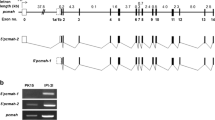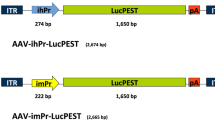Abstract
To investigate the regulation of tumor suppressor XAF1 gene expression in digestive system cancers, we studied XAF1 gene promoter transcription activity and mRNA level in digestive system cancer cell lines (human hepatoma cell line HepG2, human colon cancer cell line LoVo, and human gastric cancer cell line AGS) and nontumor cell lines (human embryonic liver cell line L02 (L02 cells) and human embryonic kidney 293 cells [HEK293 cells]) as controls. 1395-bp-promoter fragment of XAF1 gene was amplified by polymerase chain reaction (PCR) and cloned into pGL3-basic vector and pEGFP-1 vector to assay its promoter transcription activity. The plasmids were transfected into a variety of cell lines by lipofectamine 2000. The promoter transcription activity was determined by dual-luciferase report assay, and enhanced green fluorescent protein (EGFP)-positive cells were detected by fluorescence microscope. The expression of XAF1 mRNA in HEK293 and L02 were significantly higher than that in any of the three digestive system cancer cell lines. The dual-luciferase reporter assay showed that the promoter transcription activity in digestive system tumor cell lines transfected with pGL3-XAF1p promoter was apparently lower than that of both HEK293 and L02 cells. Expression of green fluorescent protein (GFP) under the control of XAF1 promoter in the three digestive system cancer cell lines was lower than that of both HEK293 and L02 cells. The activities of pGL3-XAF1p in the three digestive system cancer cell lines after treatment with heat stress were significantly lower than those in the unstressed cells. The results suggested that remarkably downregulated XAF1 mRNA expression in digestive system cancer cell lines may be due to loss of transcription activity of XAF1 promoter.
Similar content being viewed by others
References
Jacobson M D, Weil M, Raff M C. Programmed cell death in animal development. Cell, 1997, 88(3): 347–354
Horvitz H R. Genetic control of programmed cell death in the nematode Caenorhabditis elegans. Cancer Res, 1999, 59(7): 1701–1706
Thompson C B. Apoptosis in the pathogenesis and treatment of disease. Science, 1995, 267(5203): 1456–1462
Hanahan D, Weinberg R A. The hallmarks of cancer. Cell, 2000, 100 (1): 57–70
Deveraux Q L, Reed J C. IAP family proteins-suppressors of apoptosis. Genes Dev, 1999, 13(3): 239–252
Fong W G, Liston P, Rajcan-Separovic E, St Jean M, Craig C, Korneluk R G. Expression and genetic analysis of XIAP-associated factor 1 (XAF1) in cancer cell lines. Genomics, 2000, 70(1): 113–122
Liston P, Fong WG, Kelly N L, Toji S, Miyazaki T, Conte D, Tamai K, Craig C G, McBurney M W, Korneluk R G. Identification of XAF1 as an antagonist of XIAP anti-caspase activity. Nat Cell Biol, 2001, 3(2): 128–133
Plenchette S, Cheung H H, Fong WG, LaCasse E C, Korneluk R G. The role of XAF1 in cancer. Curr Opin Investig Drugs, 2007, 8(6): 469–476
Byun D S, Cho K, Ryu B K, Lee MG, Kang MJ, Kim H R, Chi S G. Hypermethylation of XIAP-associated factor 1, a putative tumor suppressor gene from the 17p13.2 locus, in human gastric adenocarcinomas. Cancer Res, 2003, 63(21): 7068–7075
Ng K C, Campos E I, Martinka M, Li G. XAF1 expression is significantly reduced in human melanoma. J Invest Dermatol, 2004, 123(6): 1127–1134
Green M, Schuetz T J, Sullivan E K, Kingston R E. A heat shockresponsive domain of human HSF1 that regulates transcription activation domain function. Mol Cell Biol, 1995, 15(6): 3354–3362
Wang J, He H, Yu L, Xia H H, Lin M C, Gu Q, Li M, Zou B, An X, Jiang B, Kung H F, Wong B C. HSF1 down-regulates XAF1 through transcriptional regulation. J Biol Chem, 2006, 281(5): 2451–2459
Smale S T. Core promoters: active contributors to combinatorial gene expression. Genes Dev, 2001, 15(19): 2503–2508
Naylor L H. Reporter gene technology: The future looks bright. Biochem Pharmacol, 1999, 58(5): 749–757
Jang J Y, Kim H J, Chi S G, Lee K Y, Nam K D, Kim N H, Lee S K, Joo K R, Dong S H, Kim B H, Chang Y W, Lee J I, Chang R. Frequent epigenetic inactivation of XAF1 by promoter hypermethylation in human colon cancers. Korean J Gastroenterol, 2005, 45(4): 285–293
Carper S W, Duffy J J, Gerner E W. Heat shock proteins in thermotolerance and other cellular processes. Cancer Res, 1987, 47 (20): 5249–5255
Hightower L E. Heat shock, stress proteins, chaperones and proteotoxieity. Cell, 1991, 66(2): 191–197
Trautinger F, Kindås-Mügge I, Knobler RM, Hönigsmann H. Stress proteins in the cellular response to ultraviolet radiation. J Photochem Photobiol B, 1996, 35(3): 141–148
Szatrowski T P, Nathan C F. Production of large amounts of hydrogen peroxide by human tumor cells. Cancer Res, 1991, 51(3): 794–798
Hileman E O, Liu J, Albitar M, Keating M J, Huang P. Intrinsic oxidative stress in cancer cells: a biochemical basis for therapeutic selectivity. Cancer Chemother Pharmacol, 2004, 53(3): 209–219
Wang D, Kreutzer D A, Essigmann J M. Mutagenicity and repair of oxidative DNA damage: insights from studies using defined lesions. Mutat Res, 1998, 400(1,2): 99–115
Wei H. Activation of oncogenes and/or inactivation of antioncogenes by reactive oxygen species. Med Hypotheses, 1992, 39 (3): 267–270
Kroeger P E, Morimoto R I. Selection of new HSF1 and HSF2 DNA-binding sites reveals difference in trimer cooperativity. Mol Cell Biol, 1994, 14(11): 7592–7603
Wang Y, Morgan W D. Cooperative interaction of human HSF1 heat shock transcription factor with promoter DNA. Nucleic Acids Res, 1994, 22(15): 3113–3118
Birch-Machin I, Gao S, Huen D, McGirr R, White R A, Russell S. Genomic analysis of heat-shock factor targets in Drosophila. Genome Biol, 2005, 6(7): R63
Author information
Authors and Affiliations
Corresponding author
Rights and permissions
About this article
Cite this article
Chen, Q., Yu, Q., Song, Y. et al. Cloning of human XAF1 gene promoter and assay of its transcription activity in a variety of cell lines. Front. Med. China 3, 148–152 (2009). https://doi.org/10.1007/s11684-009-0032-7
Received:
Accepted:
Published:
Issue Date:
DOI: https://doi.org/10.1007/s11684-009-0032-7




